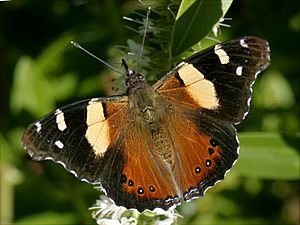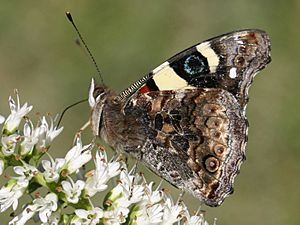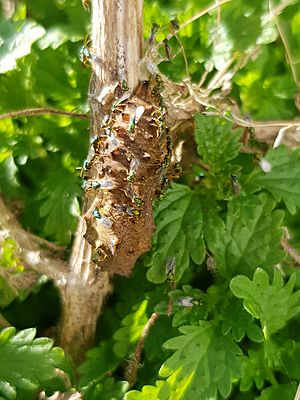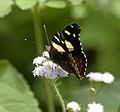Yellow admiral facts for kids
Quick facts for kids Yellow admiral |
|
|---|---|
 |
|
| Scientific classification | |
| Synonyms | |
|
The yellow admiral (Vanessa itea) is a beautiful butterfly. It is also known as the Australian admiral. You can find this butterfly in Australia, New Zealand, Lord Howe Island, and Norfolk Island.
In the Māori language, its name is kahukowhai. This means "yellow cloak," which perfectly describes its look! The yellow admiral belongs to a large group of butterflies called Nymphalidae.
Contents
What the Yellow Admiral Looks Like
This butterfly is a medium size. Its wingspan, which is how wide it is from wingtip to wingtip, is usually between 48 and 55 millimeters.
The top side of its front wings is dark brown or black. It has three small white spots. A wide, bright yellow bar crosses these wings. Closer to its body, the wings are a dull red color. The back wings are dull red with a black edge. They also have a row of black circles with light blue centers near the edge.
The underside of the wings looks very different. The back wing is a mix of brown shades. It has irregular patterns that help it blend in. The underside of the front wing has a blue eyespot. This spot is on a black background. Yellow areas highlight it above and below.
Where They Live and Their Home
Yellow admiral butterflies are quite common. You can find them wherever their favorite food plants grow. They like open areas, empty lands, and gardens. They especially like places where stinging nettles grow. These nettles are plants like Urtica incisa and Urtica urens.
These butterflies can live up to 1,000 meters above sea level. They are strong and fast flyers. Scientists believe they can even fly across the Tasman Sea from Australia to New Zealand!
Life Cycle of the Yellow Admiral
The yellow admiral butterfly goes through several stages. This is called its life cycle.
Eggs
The eggs of the yellow admiral are light green. They are shaped like tiny barrels and have ribs. Female butterflies usually lay their eggs one by one. Sometimes, they lay them in pairs. They always lay them on nettle leaves. These leaves will be the first food for the baby caterpillars.
Larva (Caterpillar)
The caterpillars can be black, grey, yellow-green, or brown. They have lighter lines and spots along their backs. They are covered in several rows of spiny bumps. Caterpillars have six true legs and ten prolegs, which are like temporary legs.
They love to eat nettles. They also eat other plants like Parietaria debilis, Pipturus argenteus, and Soleirolia soleirolii. Caterpillars eat mostly at night. During the day, they hide inside a curled leaf to stay safe. They grow to about 30 millimeters long before they change into a pupa.
Pupa (Chrysalis)
The pupa is about 20 millimeters long. It is grey or brownish. It has sharp bumps and two white or silver spots on each side. This is the stage where the caterpillar transforms into a butterfly.
Adult Butterfly
Adult yellow admiral butterflies fly during the warmer months of the year. The exact time depends on where they live. For example, in Tasmania, they fly from November to May. In Victoria, they fly from September to April.
These butterflies can live for several months. They drink nectar from flowers. Sometimes, they also feed on sap that leaks from trees. Usually, the last caterpillars of the season will stay as larvae until the next warm season. But in some places, the adult butterflies can survive winter by resting quietly.
Parasites
Sometimes, tiny wasps lay their eggs on the yellow admiral pupae. These wasps are called parasites. In New Zealand, two types of wasps, Echthromorpha intricatoria and Pteromalus puparum, are known to do this.
Images for kids
-
Mount Mee, Queensland, Australia






